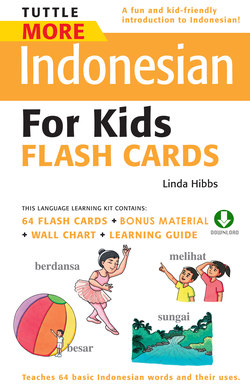Читать книгу Tuttle More Indonesian for Kids Flash Cards - Linda Hibbs - Страница 7
На сайте Литреса книга снята с продажи.
ОглавлениеHow to Use the
Tuttle MORE Indonesian for Kids Flash Cards
Selamat datang dan selamat belajar! Welcome and happy learning!
Tuttle MORE Indonesian for Kids Flash Cards is an introductory language learning kit especially aimed at children from preschool through early primary level. Basic words, phrases and sentences are presented in a fun and easy to learn way. The flash cards can be used as a learning tool in a classroom setting, at home, at parties, in travels, or anywhere that learning can take place.
About Indonesia
Indonesia is an archipelago made up of over 17,000 islands (not all inhabited). It lies on the equator, north of Australia, and has a tropical climate with a typical wet and dry season. The five main islands are Java (with Jakarta as the capital city), Sumatra, Kalimantan, Sulawesi and Bali. Each island has rich cultural traditions including regional dances, songs and music. Traditional entertainment is still very popular, including the shadow puppet performances (wayang). Indonesians love to sing and children’s songs are an integral part of the culture (some of these are included on the Bonus Material).
Indonesia has a rich abundance of wildlife including tigers, elephants, rhinoceroses, orangutans and the miniature deer called kancil. There are also beautiful birds, including the bird of paradise (cenderawasih), and a great variety of insects and reptiles including the komodo dragon (largest lizard in the world) and the friendly gecko (cicak). While the kancil has not been included in the flash card vocabulary as it is not well-known outside of Indonesia, you might like to search the Internet for some of the wonderful Indonesian kancil stories aimed at children. “The Kancil and the Crocodile” is just one example. There are many other Indonesian stories based on myths and legends that will appeal to children.
Traditional transportation methods still used in Indonesia today might also be something your child/students will enjoy finding out about. These include the becak (three-wheeled bike where passengers sit in front), andong (four-wheeled horse and cart from Yogyakarta area), dokar (two-wheeled horse and cart) and the bajaj (three-wheeled vehicle used in Jakarta).
While volcanoes might seem a bit scary to some children, others might be fascinated to know that Indonesia lies on what is known as the Ring of Fire and has over 400 volcanoes with 100 still active. A small model of a volcano can be made out of clay with a cone left in the center (insert a small plastic jar/tube). Add some bicarbonate of soda and vinegar and watch the volcano erupt…perfectly safe learning for young children!
Rice is the main crop grown in Indonesia, so nearly all meals are eaten with rice although sometimes noodles are also included. Some well known dishes include sate (savory meat on skewers grilled over hot coals), nasi goreng (fried rice) and mie goreng (stir-fried noodles). As Indonesian food is very spicy the Indonesian language includes a special word, pedas, that means spicy hot rather than panas (hot in heat).
About the Indonesian Language
Most islands in Indonesia have their own language. In fact, there are different languages spoken in different regions of each island. For example, the people of West Java speak a different language from those in Central and East Java. So that everyone could communicate and understand each other an “Indonesian language” called Bahasa Indonesia was established as the national language in 1928. It was first introduced into schools in the 1950s. While it originated from the Malay language it also incorporates words from local languages, Arabic and Dutch.
Pronouncing Indonesian
There are 26 letters, just like in the English alphabet. The only difference is the pronunciation. Indonesian is easy to pronounce since it is phonetic (spelled how it sounds). However, watch out for the various forms of e (listen carefully to the audio), and for the letter c which is pronounced ch: for example, cicak (gecko) is pronounced chi chak.
In Indonesian, syllables receive almost equal stress. If there are more than two syllables in a word (for example, selamat), there is slightly more emphasis on the second to last syllable: se-la-mat.
If you use other resources or find some helpful sites on the Internet as you explore Indonesian, you may occasionally notice some differences in spelling. This is because much of the spelling system changed in the 1970s.
The Indonesian Alphabet
Pronounced like this:
